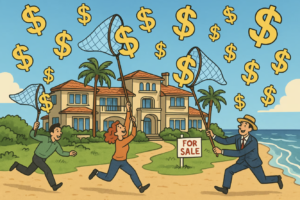1 big thing: Checking In On Housing: A Divided Market Emerges
After a bumpy few years, it seems that the housing sector is set for a robust rebound.
The big picture: It’s a good thing the market is surging back to pre-pandemic levels, but the landscape has become more complex than it was before. Real estate professionals enjoyed a simpler time pre-2020, but those days are in the rearview mirror.
A new dynamic: Single-family housing starts are increasing and interest in multifamily properties is on the wane.
Single-family starts: Up 11.6% in February; down 12.04% in March
Single-family permits: Up a bit in February by 1%; down 5.7% in March
Multifamily starts: Down nearly 44.3% compared to last year
Multifamily permits: Down more than 21% year-over-year
Yes, but: Clearly, multifamily units aren’t as popular as they used to be.
Very likely this is due to an oversupply in multifamily housing, the result of previous construction booms.
Now, builders are hitting pause on multifamily units to see if demand stabilizes.
Economic drivers: These trends aren’t happening in a vacuum. Two of the chief factors at play here:
Today’s higher mortgage rates. These incentivize current homeowners with very low rates to stay put, which means fewer single-family units on the market. New construction is intended to fill that void.
A very tight labor market. The construction industry is strengthened by the interest in new single-family builds, but a shortage of skilled workers could slow down the completion of new projects and increase costs for everyone involved.
The bottom line: Real estate professionals and investors are weighing the pros and cons of single-family versus multifamily ventures. Single-family developments may offer stable returns, while the higher risk in multi-family developments could lead to higher returns — if investors are willing to adjust their strategy as the market demands.
2. Shifting Sands in Commercial Lending

Regional banks are increasingly finding that theirs is a vulnerable position in commercial real estate. The industry is turning, instead, toward private lenders.
Why it’s a big deal: In recent years, regional banks have been completely overexposed in commercial loans. Now, as a course correction in the market, private entities are poised to swoop in and take advantage of this vulnerability.
Potential benefits for the private sector: Regulators are expected to support a consolidation effort in the interest of stabilizing the financial market.
Increasing the industry’s reliance on private lenders would go a long way toward diversifying risk profiles and could likewise stabilize the market.
Increasing private sector lending would have other benefits, too:
In many cases, private lenders are able to be more flexible and responsive than institutional banks.
If sophisticated (experienced, risk-aware) private investors can step in and lift some of the lending burden from regional banks, that could end up shifting some of the associated risk away from the public.
Growth in the commercial market: Office spaces may be lagging post-pandemic, but industrial and light industrial real estate is gaining momentum.
The nation’s ongoing supply chain woes are creating an increased demand for U.S.-based manufacturing and strategically located warehouses.
The bottom line: Shifting more commercial lending to private lenders could be a way to mitigate financial risk for everyone. But the adoption of responsive, transparent regulatory practices is critical, too, to ensure that our commercial lending environment remains as healthy as possible.
It goes without saying: Investors should always stay flexible and work with lenders they trust.

3. Catch up fast

Home prices are hitting record highs. The Title Report
Warren Buffet’s national real estate brokerage, Berkshire Hathaway HomeServices, settled its commission lawsuit for $250 million. AP
HUD adds $90 million in funding to protect homes from health hazards. HousingWire
The real estate and mortgage industry reacts to the Fed’s decision to hold rates steady while easing its balance sheet. MPAMag Online
Housing prices are rising in every major U.S. metro area for the first time in over two years. Redfin
Solving the housing crisis: What Congress must do to support real estate investors and boost housing supply. Bigger Pockets
4. Closing Thought

If people dive off cliffs over eight stories high into the sea below, they are either insane or extremely disciplined.
Why it matters: Their diagnosis depends on how they land.
Some years ago, I was in a walk-a-thon in Virginia Beach. A retired Navy SEAL was walking beside me as the emcee of the event yelled through his bullhorn from the fourth story of a nearby hotel to encourage us to raise money to find a cure for ALS.
The SEAL turned to me and said, “I’d be freaking out. No way I’d do that.” I asked, “Do what?” He replied, “Stand on that balcony up there. It’s too high. I’m scared of heights.”
Astonished, I turned and asked, “Didn’t you jump out of helicopters and planes into the ocean at night on a regular basis?”
He said, “Yeah, but that was my ‘thinking brain’ at work. On that balcony, my ‘lizard brain’ would turn me into a puddle of panic.”
At the time, I had no idea what he was talking about, but — in one of my coaching classes — I learned about brain chemistry, the prefrontal cortex and the amygdala.
The prefrontal cortex is our “thinking brain” that he’d mentioned;
The amygdala is our “lizard brain” that could reduce a 6-foot, 3-inch, 240-pound Navy Seal to a frozen panic-filled statute on a fourth-floor hotel balcony.
It’s our fight-or-flight control panel that controls a lot of our automatic functions like adrenaline release, breathing, and heartbeat.
Most successful people have learned to use their prefrontal cortex to control their amygdala, or at least to recognize when the amygdala is taking over their thinking and driving them to fight or flight and away from rational thinking.
Meditation is a tool that many entrepreneurs I’ve interviewed on the podcast use to focus their prefrontal cortex on clear and rational thinking.
They also practice their craft relentlessly to build “muscle memory” so that routine tasks and processes become automatic and easy to reproduce even under intense pressure such as deadlines, financial constraints, and physical disabilities.
They surround themselves with coaches and mentors who help them train harder and think bigger so their lizard brains don’t cause them to freeze or flee in the face of adversity.
The bottom line: Like cliff divers and BASE jumpers, business leaders have to use coaches and train their minds just as much as they train their bodies. This builds resistance to the fight-or-flight tendencies of our lizard brains when faced with a tough or new situation.
The quality and duration of that training will determine whether a swan dive into business is a graceful entry or a bellyflop.
We hope you found this helpful — any feedback is appreciated and can be shared by hitting reply or using the feedback feature below.
-
Was this email forwarded to you? Subscribe here.
-
Have an idea or issue to share? Email us.
-
Connect with us using your preferred social media and website links for MyLandTrustee and Aspire Legal Solutions.
-
Our mailing address: PO Box 547945, Orlando, FL 32854-7945
-
Our physical address: 1901 West Colonial Drive, First Floor, Orlando, FL 32804
Be on the lookout for our next issue!





